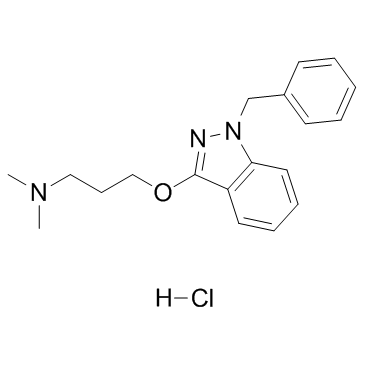Benzindamine Hydrochloride

Benzindamine Hydrochloride structure
|
Common Name | Benzindamine Hydrochloride | ||
|---|---|---|---|---|
| CAS Number | 132-69-4 | Molecular Weight | 345.866 | |
| Density | N/A | Boiling Point | 474.4ºC at 760 mmHg | |
| Molecular Formula | C19H24ClN3O | Melting Point | 147-153ºC | |
| MSDS | Chinese USA | Flash Point | 240.7ºC | |
| Symbol |

GHS07 |
Signal Word | Warning | |
|
Benzydamine N-oxygenation as an index for flavin-containing monooxygenase activity and benzydamine N-demethylation by cytochrome P450 enzymes in liver microsomes from rats, dogs, monkeys, and humans.
Drug Metab. Pharmacokinet. 30(1) , 64-9, (2015) Benzydamine is an anti-inflammatory drug that undergoes flavin-containing monooxygenase (FMO)-dependent metabolism to benzydamine N-oxide; however, benzydamine N-demethylation is also catalyzed by liver microsomes. In this study, benzydamine N-oxygenation and... |
|
|
Entrapment of human flavin-containing monooxygenase 3 in the presence of gold nanoparticles: TEM, FTIR and electrocatalysis.
Biochim. Biophys. Acta 1820(12) , 2072-8, (2012) Nanosized particles of gold are widely used as advanced materials for enzyme catalysis investigations. In some bioanalytical methods these nanoparticles can be exploited to increase the sensitivity by enhancing electron transfer to the biological component i.... |
|
|
Drug oxygenation activities mediated by liver microsomal flavin-containing monooxygenases 1 and 3 in humans, monkeys, rats, and minipigs.
Biochem. Pharmacol. 90(2) , 159-65, (2014) Liver microsomal flavin-containing monooxygenases (FMO, EC 1.14.13.8) 1 and 3 were functionally characterized in terms of expression levels and molecular catalytic capacities in human, cynomolgus monkey, rat, and minipig livers. Liver microsomal FMO3 in human... |
|
|
In vitro drug metabolism by C-terminally truncated human flavin-containing monooxygenase 3.
Biochem. Pharmacol. 83(4) , 551-8, (2012) Human flavin-containing monooxygenase 3 (hFMO3) is a microsomal drug-metabolizing monooxygenase that catalyzes the NADPH-dependent oxygenation of a wide range of drugs and xenobiotics which contain a soft-nucleophiles, usually sulfur or nitrogen. As the relea... |
|
|
Effects of salinity acclimation on the pesticide-metabolizing enzyme flavin-containing monooxygenase (FMO) in rainbow trout (Oncorhynchus mykiss).
Comp. Biochem. Physiol. C. Toxicol. Pharmacol. 157(1) , 9-15, (2013) Thioether-containing pesticides are more toxic in certain anadromous and catadromous fish species that have undergone acclimation to hypersaline environments. Enhanced toxicity has been shown to be mediated through the bioactivation of these xenobiotics by on... |
|
|
Photoallergic contact dermatitis from benzydamine presenting mainly as lip dermatitis.
Contact Dermatitis 63(2) , 85-8, (2010) Benzydamine, a non-steroidal anti-inflammatory drug (NSAID) in use for more than four decades, has been reported to cause photosensitivity.To study the results of photopatch testing to benzydamine and the clinical features of the dermatitis during a 3-year pe... |
|
|
Benzydamine as a useful substrate of hepatic flavin-containing monooxygenase activity in veterinary species.
J. Vet. Pharmacol. Ther. 33(4) , 341-6, (2010) Benzydamine (BZ), a weak base and an indazole derivative with analgesic and antipyretic properties used in human and veterinary medicine, is metabolized in human, rat, cattle and rabbit to a wide range of metabolites. One of the main metabolites, BZ N-oxide (... |
|
|
Fluorescence quenching of biologically active carboxamide by aniline and carbon tetrachloride in different solvents using Stern-Volmer plots.
Spectrochim. Acta. A. Mol. Biomol. Spectrosc. 79(5) , 1985-91, (2011) Fluorescence quenching of biologically active carboxamide namely (E)-2-(4-chlorobenzylideneamino)-N-(2-chlorophenyl)-4,5,6,7-tetrahydrobenzo[b]thiophene-3-carboxamide [ECNCTTC] by aniline and carbon tetrachloride (CCl4) quenchers in different solvents using s... |
|
|
Genotoxicity of two mouthwash products in the Drosophila Wing-Spot Test.
Food Chem. Toxicol. 48(10) , 2577-80, (2010) In this study, genotoxicity of two mouthwash products (chlorexidin, benzidamine-HCl) were investigated in the Drosophila Wing-Spot Test which makes use of the wing cell markers multiple wing hairs (mwh) and flare (flr) and detects both mitotic recombination a... |
|
|
Efficacy of topical benzydamine hydrochloride gel on oral mucosal ulcers: an in vivo animal study.
Int. J. Oral Maxillofac. Surg. 40(9) , 973-8, (2011) The aim of this study was to investigate the effect of benzydamine hydrochloride bioadhesive gel on healing of oral mucosal ulceration in an animal model. For in vivo determination of the effects of the bioadhesive gel, 36 rabbits were separated into three gr... |